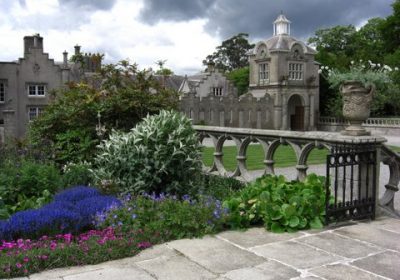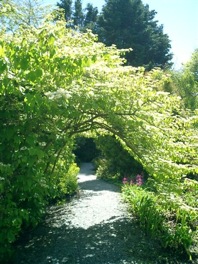Brigit’s Garden
Description
The Four Gardens
A walk through the gardens is a journey through the cycle of the year, each garden representing one of the Celtic festivals: Samhain, Imbolc, Bealtaine and Lughnasa. This seasonal cycle mirrors the cycle of life from conception to old age and death. These are wildlife gardens, designed to reflect the West of Ireland landscape and managed to encourage biodiversity.
Samhain Winter Garden
The festival of Samhain (pronounced Sow-en) or Halloween falls on the 31st October and marked the beginning of the yearly cycle for Celtic peoples. This was a time of death and the promise of re-birth, a time of waiting and reflection. It was understood that in the dark silence comes whisperings of new beginnings, the stirring of the seed beneath the ground. In the Samhain garden, the earth, in the shape of a sleeping woman, wraps around a womb-like pool. A figure of leaves cast in bronze rests on an island. The pool is enclosed in a ring of birch trees, reflecting the stark simplicity of the season. This is a place to be still, dream and prepare for the movement of spring. The earth woman is planted with meadow grasses and wild flowers.
Imbolc Spring Garden
Imbolc (pronounced Im-ulk) is the old Celtic name for the spring festival on 1st February, now St. Brigit’s Day. The birth of lambs and the first snowdrops herald this season of new life. In the Imbolc garden the path leads through hay meadow and orchard trees to a children’s glade with its delightful basketwork swings. Further on, a carved triple spiral symbolises Brigit, who is often represented as three sisters or as the three patrons of poetry, smithcraft and midwifery.
Bealtaine Summer Garden
The great fire festival of Bealtaine (pronounced Belt-an-a) or May Day celebrates the bright half of the year and the coming of summer’s warmth. This is the time for sexual awakenings, marriages and the adventures of young adulthood. Diarmuid and Grainne were mythical lovers on the run, and the Bealtaine garden features Diarmuid and Grainne’s bed, a grassy hollow facing the sun and surrounded by simple wildflowers. The lovers theme is carried through to the Flame Figures sculpture. A processional way between tall stones has copper flames set into the path and leads to a fire circle, backed by a throne in bog oak and yew. Here, the young adult can claim their personal power and sit as King or Queen in their own life.
Lughnasa Autumn Garden
The festival of Lughnasa (pronounced Loo-na-sa) in early August marks the beginning of the harvest and the transition from summer to autumn. Named after Lugh Lamh Fada, the hero of the mythical Tuatha de Dannan, it is a time of plenty and celebration. Mounds represent the constellation of Orion, which some Celts associated with Lugh.. Stone vegetable beds in spiral shapes stand to each side and host an abundance of edible plants: vegetables, flowers and herbs. Two interlinked grassy circles are enclosed with standing stones, making spaces for feasting and dancing. As we approach the end of the cycle it is time to reflect, give thanks and celebrate all that has come to fruition. Three yew trees stand outside the exit from Lughnasa, symbolising the moment of death. The cycle is now complete, and the possibility of re-birth beckons as a new cycle begins.
Roundhouse
At the centre of the gardens is the Roundhouse, a craft-built building of local limestone with an unusual circular thatched roof. Windows look out onto each of the four gardens. The Roundhouse is a place for art and music, meditation, meetings or just relaxing.
The nature trail is an attractive 800m (half-mile) walk through woodland, meadow and lakeshore. Take the trail booklet with you and follow the number posts to find out about the fascinating local ecology and the Celtic folklore associated with Ireland’s native trees. (See the Ogham trees below).
A simple trail leaflet invites children to look for things at each number post along the trail and guess the identity of the mystery animal. A great way to engage with nature and have lots of fun! Suitable for children with an accompanying adult.
Living Willow Play Area
Have fun exploring the tunnels and play domes, all woven from living willow trees. Created in 2005 by Katrin Schwart with assistance from students attending a Living Willow Workshop at Brigit’s Garden.
The Ring Fort (Fairy Fort)
This circular enclosure dates from early historic to mediaeval times. Its Irish name is Cnochán na Ceárta, hill of the forge, suggesting a history of craft activity on site. Ring forts are also known as fairy forts because when people no longer used a ring fort, the fairies moved in.
The Ogham Trees
Ogham (pronounced Ohm) is an ancient alphabet, probably dating from the 2nd- 4th century. The Ogham letters consisted of a series of notches carved on a stone or piece of wood, and many Ogham stones can still be seen in Ireland and Britain. In the best-known Ogham, each letter is associated with a tree, though Ogham also related to objects and places.
In early Ireland trees were of great symbolic and ritual significance as well as being economically important; so there is a rich folklore and mythology attached to different tree species. Ogham may have encoded much of the nature-based wisdom of the Druids. In the old tale of Midhir and Etáin, the mortal queen Etáin and her divine lover Midhir transform into swans and elope together. King Eochaid searches for the lovers in vain until he consults a Druid named Dulan. The Druid inscribed Ogham on wands of yew and used these to reveal their hiding place.
Garden Design
We asked Mary Reynolds, winner of the Gold Medal in the Chelsea Flower Show 2002, to design the four seasonal gardens for Brigit’s Garden on the theme of the Celtic festivals. Mary had started on the project before her Chelsea win and completed the design later in 2002.
At 16 metres (50 feet) in diameter the calendar sundial tells with great accuracy not only the time of the day but also the month of the year. The shadow is cast by a 1.75 metres (5 feet) spike of bog oak, and the sundial comprises 15 elegant curved lines showing the path of the shadow on the first day of each month and on the equinoxes and solstices. As the length of the shadow varies with the seasons, these lines enable the viewer to read the date as well as the time.
The name Brigit means ‘Exalted One’. The name refers both to St Brigit, the powerful 6th century abbess of Kildare, and the pre-Christian Brigit, goddess for many Celtic peoples across Europe. Many of the stories associated with St Brigit are clearly pre-Christian in origin, so the two Brigit’s are inextricably linked.


The figure of Brigit embodies the Celtic wisdom of the natural world, wisdom that is relevant today as we struggle to find ways of living sustainably on the earth. Brigit was closely connected with the elements of fire, water, earth and air. She is often represented in a triple form as three sisters or three related deities. In Irish tradition she was patron of poetry and craftwork, and as midwife and nurturer she underpins the seasonal cycle and the human life cycle.





